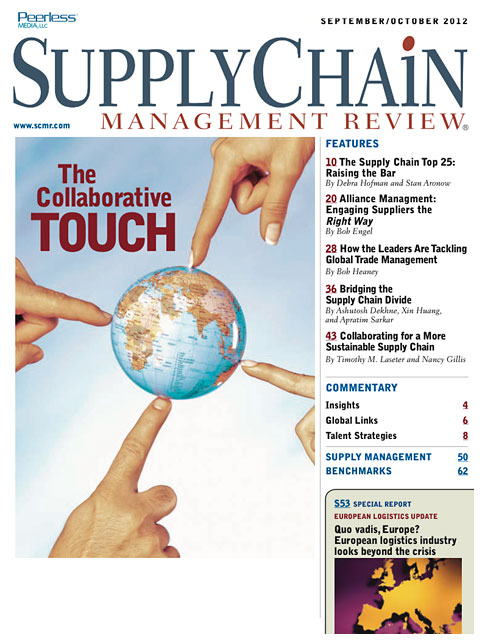Sorry, but your login has failed. Please recheck your login information and resubmit. If your subscription has expired, renew here.
September-October 2012
The Supply Chain Top 25 rankings from Gartner Inc. is one of the most eagerly anticipated indicators of supply chain excellence. This year’s leaders share certain characteristics that drive day-to-day performance while solidifying the foundation for future growth. Gartner’s Debra Hofman and Stan Aronow tells how their standout performance is raising the supply chain leadership bar for companies everywhere. Browse this issue archive.Need Help? Contact customer service 847-559-7581 More options
On October 5, 2009, President Obama signed an executive order entitled “Federal Leadership in Environmental, Energy, and Economic Performance.” Rather than debating
the contentious issue of climate change, the policy statement made greenhouse gas emissions (GHG) reductions a priority for the government and tasked the General ervices Administration (GSA), the government’s procurement agency, to reduce the GHGs from the federal supply chain. On the surface, the order appeared to fall in a long line of Executive Orders, issued under different administrations, that addresses sustainability primarily through an environmental lens. Clearly, environmental protection is a societal good and accordingly, the government should lead the way.
The surprising result from implementing the order, however, has been the realization that businesses have found a strong economic case for sustainability beyond merely responding to environmental mandates. Increasingly, emphasis on sustainable supply chains, ones that reduce resource-related inefficiencies and risks, are seen as a competitive necessity. It is this awareness that is driving leading businesses—from Coca Cola to Johnson Controls to Dell and Alcoa—to employ sustainable supply chain practices. Accordingly, GSA announced in March 2012 at a Council on Environmental Quality (CEQ) White House event the launch of a Sustainable Supply Chain Community of Practice. The goal of the initiative: to provide federal agencies and their small business suppliers an avenue to learn from companies that have some of the most advanced supply chains in the world.
Sustainability represents an ongoing journey rather than a destination—even among global leaders. And at this early stage for the federal government, we can only
explain the origins and the emerging sketch of the future vision. But, by drawing upon the experiences of public and private organizations the world over, we hope to
demonstrate the value of the path now taken.
 |
This complete article is available to subscribers
only. Click on Log In Now at the top of this article for full access. Or, Start your PLUS+ subscription for instant access. |
Not ready to subscribe, but need this article?
Buy the complete article now. Only $20.00. Instant PDF Download.
Access the complete issue of Supply Chain Management Review magazine featuring
this article including every word, chart and table exactly as it appeared in the magazine.
SC
MR
Sorry, but your login has failed. Please recheck your login information and resubmit. If your subscription has expired, renew here.
September-October 2012
The Supply Chain Top 25 rankings from Gartner Inc. is one of the most eagerly anticipated indicators of supply chain excellence. This year’s leaders share certain characteristics that drive day-to-day performance… Browse this issue archive. Access your online digital edition. Download a PDF file of the September-October 2012 issue.
 |
Download Article PDF |
On October 5, 2009, President Obama signed an executive order entitled “Federal Leadership in Environmental, Energy, and Economic Performance.” Rather than debating the contentious issue of climate change, the policy statement made greenhouse gas emissions (GHG) reductions a priority for the government and tasked the General Services Administration (GSA), the government’s procurement agency, to reduce the GHGs from the federal supply chain. On the surface, the order appeared to fall in a long line of Executive Orders, issued under different administrations, that addresses sustainability primarily through an environmental lens. Clearly, environmental protection is a societal good and accordingly, the government should lead the way.
The surprising result from implementing the order, however, has been the realization that businesses have found a strong economic case for sustainability beyond merely responding to environmental mandates. Increasingly, emphasis on sustainable supply chains, ones that reduce resource-related inefficiencies and risks, are seen as a competitive necessity. It is this awareness that is driving leading businesses—from Coca Cola to Johnson Controls to Dell and Alcoa—to employ sustainable supply chain practices. Accordingly, GSA announced in March 2012 at a Council on Environmental Quality (CEQ) White House event the launch of a Sustainable Supply Chain Community of Practice. The goal of the initiative: to provide federal agencies and their small business suppliers an avenue to learn from companies that have some of the most advanced supply chains in the world.
Sustainability represents an ongoing journey rather than a destination—even among global leaders. And at this early stage for the federal government, we can only explain the origins and the emerging sketch of the future vision. But, by drawing upon the experiences of public and private organizations the world over, we hope to demonstrate the value of the path now taken.
 |
SUBSCRIBERS: Click here to download PDF of the full article. |
SC
MR

Latest Supply Chain News
- Humanoid robots’ place in an intralogistics smart robot strategy
- Tips for CIOs to overcome technology talent acquisition troubles
- There is still work to do to achieve supply chain stability
- Blooming success: The vital role of S&OE in nurturing global supply chains
- Supply chain salaries, job satisfaction on the rise
- More News
Latest Resources

 Explore
Explore
Latest Supply Chain News
- Humanoid robots’ place in an intralogistics smart robot strategy
- Tips for CIOs to overcome technology talent acquisition troubles
- There is still work to do to achieve supply chain stability
- Blooming success: The vital role of S&OE in nurturing global supply chains
- Supply chain salaries, job satisfaction on the rise
- How one small part held up shipments of thousands of autos
- More latest news
Latest Resources

Subscribe

Supply Chain Management Review delivers the best industry content.

Editors’ Picks





